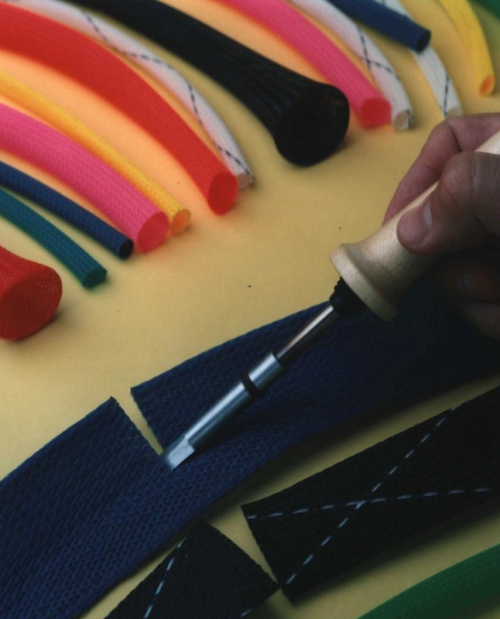
A hot knife is an electric tool with a heated blade that can be used to cut, shape, and seal synthetic materials. How to use a hot knife is relatively easy. The super-heated blade can be used to cut through and seal material easily. It can create a seamless edge to such materials as carpets, gaskets, sailcloth, webbings or ropes. Though it has industrial applications, you’ll also find it in labs, kitchens, workshops, and hobby or craft stores.
A heavy-duty hot knife cuts cleanly and seals permanently. Cutting material with scissors, a razor blade or a rotary cutter will leave the edges frayed and eventually unravel. The hot cutting knife melts the polymer filaments of the synthetic fabric precisely. It cuts the material to the desired length and fuses the loose ends of the filaments together to prevent fraying of the cut end once it has been installed or applied.
How to Use a Hot Knife
Cutting with a handheld hot knife is relatively easy. The tool has a double-edge copper hot knife tip, which slides on or off over the heating element to sharpen when needed. Plugged in, the element heats in seconds. To cut, hold the hot knife as you would a pen or pencil and cut through the material.
Preparing to cut is important. When cutting with a handheld hot knife, place the material flat on a surface. Whether a table or a counter, the cutting area should be covered with a glass sheet, otherwise the surface will not only be permanently damaged, become rough and uneven, but could also permanently adhere to the material you are cutting, thereby ruining it.
Depending on your pattern or design, you can use a metal ruler or yardstick, a dinner plate or cup, to make your pattern or guide you, or simply freehand cutting.
Always cut in a well-ventilated area and avoid inhaling the fumes from the melting material. Handle the tool with caution, the blade and the cut ends of your material are extremely hot.
Once the blade is heated, it truly does cut like a hot knife through butter. As you begin to cut through material do not pause with the blade on the fabric. Doing so will cause the material to build up under the blade and not slice through the fabric or material evenly. Cut ropes, sailcloth, carpeting and upholstery fabrics to desired sections, lengths, designs or patterns. A hot knife speeds production by allowing you to cut all of your materials in advance, and then apply or install the precut lengths at your leisure without any concerns that the material will fray or unravel.
Uses for a Hot Knife
Keep in mind that the hot knife cuts through synthetic material by melting it. A hot knife will not work on natural materials because natural fabrics do not melt, they char and burn, and fray and unravel. Synthetic fabrics such as polyester, acrylic, Dacron, and nylon used in upholsteries, ropes, carpets, and clothing cut well with a hot knife. Whereas, natural fabrics or material like cotton, cotton blends, wool, or leather do not cut well with a hot knife.
Whether for use in industry, the trades, or on household projects, the applications for the hot knife are extensive. Hot knife applications include, rubber processing in the tire and automotive trade, manufacturers of molded die-cast and extruded parts, switch and distribution boards, rubber coating removal, wire stripping, adhesive removal, terminating fiber optics, electrical installation, and cutting and sealing synthetic fabrics. They are used by furniture manufacturers, in cutting and designing upholstery and carpeting, in the marine industry for cutting and sealing roping, in laboratories and research, in sealing packages, by artists, model makers, and architects, door and window manufacturers, and building contraptions.
See our Heavy Duty Hot Knife and Tips product page here for more information.

